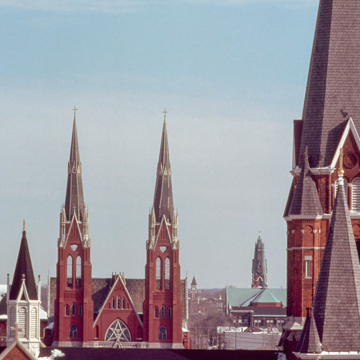After German and Irish Catholics had outgrown their small room at Ste. Anne de Detroit Church, in 1841 Father Martin Kundig directed construction of the original steepled brick St. Mary's Church at the southeast corner of St. Antoine and Croghan (Monroe Avenue) streets. Organized after the French Ste. Anne de Detroit and the Irish Most Holy Trinity, this parish is the third oldest in Detroit. In 1884 its original building was demolished to make way for the present church.
The present church is the major work of Dederichs (1856–1924), a noted designer of Roman Catholic churches who was born and trained in Germany and who was a lifelong member of this parish. The church shows distinct evidence of its German influence. Twin towers with spires mark the triple-arched portico that is surmounted by a large rose window. Polychromatic red brick and limestone cover the exterior walls. Walls have round-arched windows. The interior, which seats 1,200, is a basilica plan with transepts. The towering, double-columned, Corinthian oak altar dates from 1855 and comes from the earlier church. It features a statue of Mary flanked by likenesses of King Wenceslaus of Bohemia and Queen Elizabeth of Hungary, a reference to the ethnicity of the first parishioners. Surrounding the main altar is a recessed, seven-sided, domed apse in which paintings depict the seven sacraments. The church's upper clerestory displays paintings of the fifteen mysteries of the rosary. The interior of the church sparkles brightly as a result of the lively refurbishing in 1986 in celebration of the centennial of the building's construction. Unfortunately, during an earlier restoration in 1969, the brick of the exterior walls was damaged by sandblasting.
St. Mary's Catholic School (now St. Mary's Community Center) was built at 1035 St. Antoine Street. The large brick Italianate building with paired, narrow round-arched windows and bracketed hipped roof replaced earlier schools. The Franciscan fathers erected their brick residence at 646 Monroe Avenue, just east of the church. The Convent of the Sisters of Notre Dame stands at 1032 St. Antoine Street. This huge German Catholic complex once included an orphan asylum for girls. St. Mary's was also the home of Detroit's first African American and Latino missions.
This large church says something of the substantial German population in the city of Detroit in the nineteenth century and of the German influence both in this building and in the architecture of Detroit as a whole.







